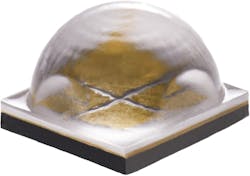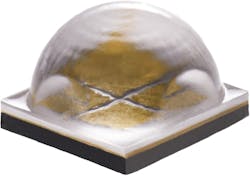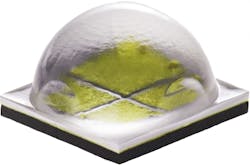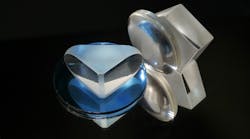LEDs push lumen output for applications such as stadium lighting but also deliver system cost savings in indoor SSL applications such as directional track lighting.
Cree (NASDAQ: CREE) has announced the XLamp XHP50 and XHP70 packaged LEDs as the first available members of the company's Extreme High Power (XHP) line that is based on the SC5 (Silicon Carbide 5) technology platform announced back in November 2014. The 5×5-mm XHP50 family delivers a maximum of 2546 lm at 19W while the 7×7-mm XHP70 family delivers a maximum of 4022 lm at 32W. The company says that the new LEDs offer double the light output of existing LEDs in the same package sizes.
As has been the case for Cree over the last year, the company is touting the solid-state lighting (SSL) system cost advantages of the new packaged LEDs. Greater light out of smaller packages results in a smaller printed-circuit board (PCB), simpler optics, a smaller housing, and fewer assembly steps, according to Cree. The company claims the new LEDs will reduce system cost by as much as 40%.
Cree made similar claims when it introduced the new MH-B family of packaged LEDs back in September as an alternative to mid-power devices. The new LEDs, however, clearly target applications that are still dominated by high-power LEDs. The company suggests that the LEDs will target high-output applications such as stadium or high-bay lighting, but also applications such as tracks where tight beam patterns are required.
Already some SSL manufacturers are planning to use the new packaged LEDs that are sampling now with production quantities available with what Cree calls its standard lead times. "Cree’s new technology is game-changing compared to the incremental advances of other LED suppliers," said Nate Heiking, advanced lighting product manager at Kenall Lighting. "The breakthrough performance of XHP LEDs enables both new design possibilities and dramatically lower system costs for LED lighting. We’re excited that Cree’s new class of Extreme High Power LEDs will accelerate customer adoption of LED lighting."
At the maximum lumen output, the new LEDs deliver efficacy in the 125–132 lm/W range. But few development teams will drive the LEDs at such high current levels. Cree specifies operational parameters at an elevated 85°C. A XHP50 5000K-CCT LED with CRI of 80 delivers 970 lm at the rated temperature for efficacy in the 115 lm/W range. The output drops to 840 lm and efficacy of about 100 lm/W for a 2700K warm-white LED. In both cases, those values were for packaged LEDs operated at 8.4W.
The new LEDs are also unique in that the development team can choose between a forward voltage of 6V or 12V via a PCB configuration. The LEDs integrate four emitters, as you can see in the nearby photo. The four devices can be connected in series for a 12V string if the PCB shorts the connection between two 6V strings. The PCB can also drive the two 6V strings in parallel. The data sheets for the new LEDs characterize both configurations.
Cree offers the LEDs across a broad range of CCTs and generally with 70-, 80-, and 90-CRI options for SSL developers. At the warmer end of the spectrum, 3500K and below, Cree will offer color consistency of 2- or 3-step MacAdam ellipse bins using its EasyWhite technology to mix emitters in a way that ensures the specified color performance.
Clearly, the new SC5 platform and these first packaged LEDs built on it are strategically important for Cree. "Cree’s new Extreme High Power LEDs demonstrate our belief that high-power LEDs are what will drive the industry towards the next generation of lighting system designs," said Dave Emerson, vice president and general manager for Cree LEDs. "Leveraging our groundbreaking SC5 Technology Platform, Cree’s new XHP LEDs deliver not only exceptional performance, but also enable up to 40% system-level cost reductions."







